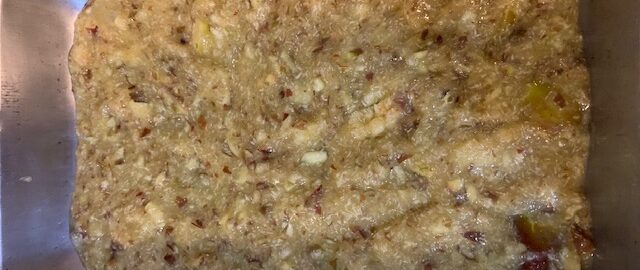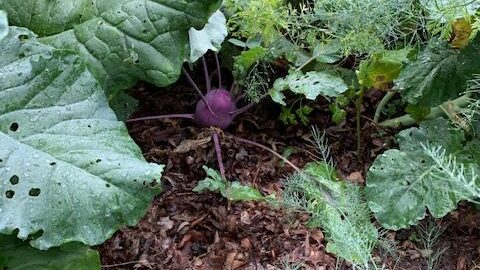Sunchokes

If you are a gardener, you are likely planning what to plant for the 2022 growing season right about now. I wanted to put in a plug for sunchoke tubers for lots of reasons:
- the tubers are versatile and make delicious soups, roasted or stir-fried vegetables, “pickles”, and raw salad garnish.
- they are low-glycemic or low starch even though they resemble potatoes–the carbohydrate in them is called inulin and is a good gut microbe prebiotic. See this recipe for how to roast them–I recently mixed 2 small potatoes, 4 large sunchokes and 1/2 sweet red pepper with the seasonings in the recipe.
- they are easy to grow and prolific–meaning 1 plant makes A LOT of tubers (see the picture which shows 1 plant being dug up).
- the tubers remaining in the ground will make a new crop the following year.
- they store very well in the ground over winter (as long as you mulch them heavily with straw or leaves) so you can dig them up as you need them.
- the beautiful sunflower-like yellow flower is enjoyed by pollinators and makes a nice cut flower (the painter Monet thought so) if you can reach it! (plants can reach 8 ft. tall).
- they spread which is good as long as they are harvested so keep them in a restricted area of the garden. Give them a try!
Meyer Lemon Tree–The Best House Plant!

Meyer lemons are prized as gourmet lemons. Amazingly enough, they are easy to grow as house plants. I have had the same one for over 15 years now and it has consistently produced lemons except for a few years when I wasn’t paying enough attention to it–this year it made 40 lemons despite a trunk diameter of no more than 1.5 inches! This picture has a tangerine tree in front of the lemon but you can see the lemons. The pots are on plastic trays with wheels that make it easy to move around.
From November to March it’s inside in front of a sunny window and we enjoy its fragrant blossoms in late winter. On warm early Spring days we move it outside for the day so the honeybees can pollinate the flowers. Tiny green lemons form and grow all summer long and can be harvested in late Fall once fully yellow. During the warm months of the year we have it outside in full sun on the deck. From a permaculture point of view this is an ideal house plant–it serves many desirable functions. We are so enamored with this tree that we eat the lemon rinds too by drying and grinding for seasoning/tea or candying them in just maple or coconut syrup (1 Tbsp. with chopped rind of 1 lemon simmered with an occasional stir in a shallow pain until rind is soft and has absorbed all the liquid-keep in refigerator). If you decide to try your green thumb with a Meyer lemon, in can help maintain it to foliar feed it once a week with an organic liquid fertilizer (such asSpray’n grow) or to use Espoma organic citrus fertilizer 4 times a year. Give it a try!
Chick Peas and Delicata Squash with Rice
Good winter meal–warming and filling. This type of squash compliments the chick peas very nicely so do your best to find a delicata. Our local Earthfare store carries them.
Just serve with a salad for an easy meal.
Serves 2-4
Rice:
1 cup brown basmati rice, rinsed well and drained
1 and 1/2 cups water,
1/2 tsp. sea salt
Vegetables:
4 Tbsp. ghee
1 cup chopped yellow onion2 tsp. ground cumin
1 and 1/2 cups finely chopped delicata squash (do not peel the squash–just wash well, cut in half and remove the seeds and then cut each half lengthwise again and cut crosswise in 1/4 inch pieces)
2 cups COOKED chick peas
2 Tbsp. organic tamari
2 Tbsp. nutritional yeast flakes
1 cup water
sea salt and pepper to taste
cayenne to taste, optional
Start the rice first. Place rinsed and drained rice in a sauce pan and add water and salt. Bring to a boil and immediately reduce heat so the mixture just simmers. Cover with a lid. Do not remove the lid until 30 minutes of simmering and if all the water is absorbed, remove from heat. If some water remains, cover again and simmer another 5-10 minutes until all the water is absorbed. Keep covered but set aside until vegetables are ready.
Melt the ghee in a large skillet. Add the onions and stir over medium heat for a few minutes. Add the cumin and stir again. Add the squash and stir well and cook for a few minutes more before adding water and tamari. Once the mixture starts to simmer reduce to low heat and cover with a lid for 10 minutes. Once squash is cooked through add chick peas and nutritional yeast and stir well. Bring to a simmer again and remove from heat. Season with salt and pepper to taste. Serve in bowls over rice immediately.
Superfood Pancakes

Special occasion pancakes for sure! Maybe for a birthday or other celebration? The good news is these pancakes taste like dessert with the optionals but have no added sweetener if made as plain blueberry pancakes. This is a gluten-free and sugar-free, quick and easy recipe filled with superfoods that kids will love.
Serves 2
1 cup finely shredded dried coconut
1/2 cup arrowroot flour
1/4 cup whole flax seed, ground in a blender
1 large ripe pear, skinned and cored
1 tsp. baking powder
1/4 tsp. sea salt
4 eggs
1/2 cup coconut milk or water
1 cup fresh or frozen blueberries
1/4 cup walnut pieces, optional
1/4 of a bar of 85 to 90% dark chocolate, cup up in 1/2 inch square pieces or 2 Tbsp. chocolate chips, optional
ghee and honey as topping, optional
In a food processor place the coconut, arrowroot, ground flax seed, baking powder, and salt. Pulse just enough to mix well. Add chopped pear, eggs, and coconut milk or water. Process until thoroughly blended.
Heat a skillet over medium heat. Add a little ghee just to grease the bottom lightly–use a spatula to spread evenly. As soon as the pan is hot, spoon 2-3 Tbsp. of batter per pancake. Immediately place 6 or so blueberries on each pancake and a few walnut pieces if desired. Adjust the heat down if necessary so the pancakes do not burn–3-5 minutes per side usually does it in my pan. When you see little bubbles forming on the outside it’s time to flip them. If desired, place a few chocolate pieces or chocolate chips on the top after flipping–they will melt while that side down cooks. Gently spread the melted chocolate over the top. Place on a plate and top with a tsp. of ghee and some honey if desired. A 1/2 tsp of honey per pancake is all it takes to sweeten these up. Serve while warm.
Bacon Rollups
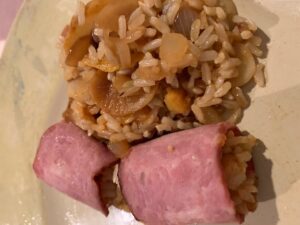
This is a quick meal if you have some bacon and leftover brown rice on hand. We use organic turkey bacon, but preferably bacon should also be from pasture-raised animals whether it is turkey or pork. Also, these would be good for breakfast or lunch and kids will love them. Use other vegetables for the rice mixture if you wish and serve some extra of this rice mixture with the rollups.
Serves 2
4 strips of bacon
2 cups cooked brown rice
2 Tbsp. ghee
1 cup finely chopped onion
1 cup finely chopped squash–I used delicata which is the most delicious in my mind but not so easy to find
1 cup thinly sliced rounds of daikon radish, if the radish is large half it or quarter it lengthwise before slicing
1 tsp. ground cumin seed
Organic tamari to taste (replace with salt if desired); and optional hot pepper sauce to taste
Melt the ghee in a large skillet over medium heat. Add the onions and stir a few times for 5 minutes to slightly brown the onions. Add the other vegetables and stir well. Continue to heat over medium heat stirring a few times for another 5 minutes until the vegetables are all tender or easily pierced with a fork. Stir in the rice. Heat for another few minutes. Season with cumin and tamari or salt, to taste. Add hot pepper sauce if desired. Set aside rice mix and cook the bacon however you like–I use a toaster oven set at 350 degree F for five minutes or so. Place the bacon on a plate and spoon some rice mixture on each strip. Spread it evenly while pressing it down. Roll up the bacon and serve on a plate with some extra rice mixture. Enjoy while still warm but I suppose they would be good cold too.
Easy Butternut Squash
Thinking of putting up more food? Don’t forget the vegetables that store very well with no fuss. Butternut squash and sweet potatoes are on the top of the list. We grow them and usually have 30-40 butternuts that we store and eat over the winter months. They keep amazingly well in a cool basement. And don’t forget that butternut squash make excellent “pumpkin” pies.
An easy way to prepare butternut is to bake it whole in a baking pan in a 350 degree F oven for about an hour or until it is soft–a knife should easily pierce the top end (not the round end with the seed cavity). Remove from the oven and cut in half. Scoop out the seeds with a spoon and discard. Cut into serving sizes leaving the skin. Top each serving with 1 tsp of ghee or butter. Season with dried onion powder, salt, and other herb seasoning of your choice if desired. Eat out of the skin (discarding the skin) while still warm.
Fig Leather
Figs are usually eaten dried, but if you have fresh figs in excess this recipe idea is a breakthrough. It may have limited relevance–how many of you have a fig tree? Or a farmers market where they are available? Well, this recipe is for you! If you are a gardener, I highly recommend planting a fig tree. Here in Roanoke we have a brown turkey variety (in a protected sunny location) that has survived the winters for several years now. It dies back during colder winters but even without protecting it by wrapping it for winter, it continues to survive and produce. It is easy to grow organically as there are really no pest problems that we have had. Anyway, making fruit leather is an easy way to preserve this highly perishable fruit. No cooking and no added sugar necessary–a real plus considering what canning recipes suggest.
I used a 140 degree F convection drying oven overnight but you could use a food dehydrator. If you do, follow their directions because it will likely take longer to dry if you dry at a lower temperature. Be sure the leather is thoroughly dried before ending drying–press the center with your finger and if there is no indentation it is dry. Also be sure to remove the leather from the pan before it cools or it will stick to the pan–follow the precautions in the update below so you don’t end up with stuck-to-the-pan fruit leather!
Wash at least 1 quart of fresh figs–any variety. Cut the stems off–if there is white flesh around the stem that does not taste sweet remove it with the stem (some fig varieties will have this more than others). Quarter the figs and place in a food processor. Pulse a few times just to mash them into a puree–not to the point of being a smooth consistency. You want it a little chunky. If you want to reduce browning stir in 2 tsp. lemon juice per quart of fresh fruit. Pour into pyrex or stainless steel baking pans to a depth of between 1/4 to 1/2 inch (no more).
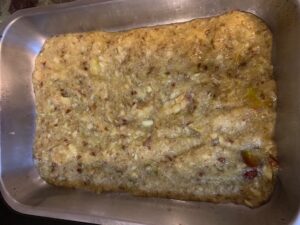
Place in a 140 degree F oven. I have a convection drying option which works well. Depending on how much moisture is in your figs and how thick the paste is in your pan will determine the drying time. Your final product will be just like fruit leather–sweet and chewy which means it sticks to your teeth so watch out for that! If you don’t dry it long enough it will be somewhat spongy or gelatinous and won’t keep as well nor taste as good in my opinion.
IMPORTANT UPDATE: If you are using regular baking pans (not a dehydrator), please take note or you may have a lot of trouble removing the leather from the pan. After making several batches of fig leather I have found that taking the following steps makes removing the leather from the pan easy.
- Cut the leather when it is half dry–it will be shiny but still spongy and will still indent when pressed in the center (see photo below). It needs to be dry enough that it doesn’t tear. This may be after 6 to 9 hours of drying time–depends on the thickness of the fruit puree. Do this while the leather is still warm–immediately after taking out of the oven.
- Lift the cut pieces (strips or squares) with a spatula and flip over. Place the pan back in the drying oven and continue drying until it’s perfect (no indentation left after pressing with your finger).
- I have also greased my pans with a very little amount of ghee. It is hardly noticeable in the final product but if you follow the two steps above you won’t need the ghee.
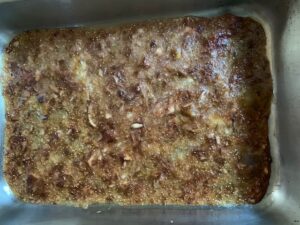
Remove from oven and immediately remove the pieces from the pan with a spatula. It should lift right out if you followed the steps above. Here are the squares
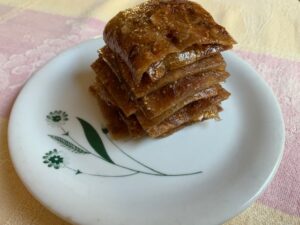
and the rolled up strips. Roll the strips up while still warm.
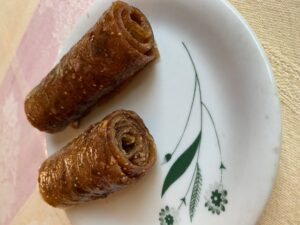
Cool completely before storing. Store in an air-tight zip lock bag or a container or roll up in plastic wrap–vacuum pack if you have the equipment. Apparently, moisture in the air is a problem for dried fruit so keeping it air-tight is very important. Fruit leather is said to store at room storage if tightly wrapped for about 1 month (mine stored at room temperature for months) and for 1 year if kept in the freezer (I haven’t tried freezing it.). If it is vacuum sealed it would likely keep at room temperature a lot longer than a month.
Strawberry Kevita Slush
Want a healthy slush to cool off and refresh? The carbonation from the Kevita (a cultured coconut water beverage available in health food stores) gives this drink nice fizz. And it supplies real food–real fruit without being high glycemic. It’s a good idea to keep some frozen fruit in the freezer whether for ice cream/sorbet or smoothies/slushes. You could use any berries in this recipe.
Serves 1
3/4 cup frozen strawberries
1 cup mojita lime mint Kevita
monk fruit powder or stevia to sweeten more to taste
Place all ingredients in a blender and blend until smooth. Enjoy sipping before it looses its fizz.
Kohlrabi
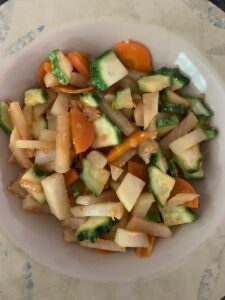

Kohlrabi is an interesting vegetable to grow and to eat–look at the picture and the way it grows in a bulb shape right at ground level with leaves whirling out. This variety is purple but once peeled it is almost white inside. It’s not commonly eaten in the US but it likely can be found in markets with good organic produce sections or at your local farmers markets. Even though it is in the cruciferous family with cabbage and broccoli it is mild tasting. I know some folks like to eat it raw but this family of vegetables is better for you cooked until just tender.
Serves 2-4
1 kohlrabi, about 4 inches in diameter, peeled and cut into match-stick size pieces
1 carrot, cut in 1/8-inch half-rounds
1 small zucchini, 6-8 inches long, cut in 1/4-inch quarter rounds
2 Tbsp. ghee
2 large cloves garlic, peeled and crushed
tamari or chickpea miso to taste
salt and black pepper to taste if desired
red pepper flakes to taste if desired
Prepare/slice all vegetables but keep separate. Melt the ghee in a large skillet over medium heat. Add the garlic, stir and add the kohlrabi right away so that the garlic does not brown or burn. Stir well and cover with a lid for a few minutes. Add the carrot, stir well and cover again. Give this mixture a stir every few minutes and cook with the lid on until just tender–maybe 5 minutes or so. Add the zucchini, tamari or miso (mix 1 Tbsp. miso with 2 Tbsp. water before adding), and the rest of the seasonings and stir well. Turn the heat off and keep covered for 5 more minutes to allow the zucchini to cook. Add more seasonings to taste if desired and serve immediately.




